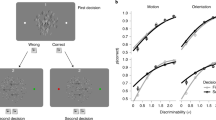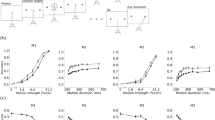Abstract
Statistical inference is the optimal process for forming and maintaining accurate beliefs about uncertain environments. However, human inference comes with costs due to its associated biases and limited precision. Indeed, biased or imprecise inference can trigger variable beliefs and unwarranted changes in behaviour. Here, by studying decisions in a sequential categorization task based on noisy visual stimuli, we obtained converging evidence that humans reduce the variability of their beliefs by updating them only when the reliability of incoming sensory information is judged as sufficiently strong. Instead of integrating the evidence provided by all stimuli, participants actively discarded as much as a third of stimuli. This conditional belief updating strategy shows good test–retest reliability, correlates with perceptual confidence and explains human behaviour better than previously described strategies. This seemingly suboptimal strategy not only reduces the costs of imprecise computations but also, counterintuitively, increases the accuracy of resulting decisions.
This is a preview of subscription content, access via your institution
Access options
Access Nature and 54 other Nature Portfolio journals
Get Nature+, our best-value online-access subscription
$29.99 / 30 days
cancel any time
Subscribe to this journal
Receive 12 digital issues and online access to articles
$119.00 per year
only $9.92 per issue
Buy this article
- Purchase on Springer Link
- Instant access to full article PDF
Prices may be subject to local taxes which are calculated during checkout








Similar content being viewed by others
Data availability
The datasets generated during and analysed during the current study are freely available online on figshare: https://figshare.com/projects/Efficient_stabilization_of_imprecise_statistical_inference_through_conditional_belief_updating/140170.Source data are provided with this paper.
Code availability
The analysis code supporting the reported findings is freely available online on github: https://github.com/juliedrevet/CONDINF.
References
Wald, A. & Wolfowitz, J. Optimum character of the sequential probability ratio test. Ann. Math. Stat. 19, 326–339 (1948).
Bogacz, R., Brown, E., Moehlis, J., Holmes, P. & Cohen, J. D. The physics of optimal decision making: a formal analysis of models of performance in two-alternative forced-choice tasks. Psychol. Rev. 113, 700–765 (2006).
Green, D. M. & Swets, J. A. Signal Detection Theory and Psychophysics (John Wiley, 1966).
Drugowitsch, J., Wyart, V., Devauchelle, A.-D. & Koechlin, E. Computational precision of mental inference as critical source of human choice suboptimality. Neuron 92, 1398–1411 (2016).
Wyart, V. & Koechlin, E. Choice variability and suboptimality in uncertain environments. Curr. Opin. Behav. Sci. 11, 109–115 (2016).
Findling, C. & Wyart, V. Computation noise in human learning and decision-making: origin, impact, function. Curr. Opin. Behav. Sci. 38, 124–132 (2021).
Glaze, C. M., Kable, J. W. & Gold, J. I. Normative evidence accumulation in unpredictable environments. eLife 4, 1–27 (2015).
Murphy, P. R., Wilming, N., Hernandez-Bocanegra, D. C., Prat-Ortega, G. & Donner, T. H. Adaptive circuit dynamics across human cortex during evidence accumulation in changing environments. Nat. Neurosci. 24, 987–997 (2021).
Palminteri, S., Wyart, V. & Koechlin, E. The importance of falsification in computational cognitive modeling. Trends Cogn. Sci. 21, 425–433 (2017).
Stocker, A. A. & Simoncelli, E. P. Noise characteristics and prior expectations in human visual speed perception. Nat. Neurosci. 9, 578–585 (2006).
Luu, L. & Stocker, A. A. Post-decision biases reveal a self-consistency principle in perceptual inference. eLife 7, e33334 (2018).
Lange, R. D., Chattoraj, A., Beck, J. M., Yates, J. L. & Haefner, R. M. A confirmation bias in perceptual decision-making due to hierarchical approximate inference. PLoS Comput. Biol. 17, e1009517 (2021).
Soltani, A. & Izquierdo, A. Adaptive learning under expected and unexpected uncertainty. Nat. Rev. Neurosci. 20, 635–644 (2019).
Griffiths, T. L. & Tenenbaum, J. B. Optimal predictions in everyday cognition. Psychol. Sci. 17, 767–773 (2006).
Sutton, R. S. & Barto, A. G. Reinforcement Learning: An Introduction (MIT Press, 1998).
Findling, C., Skvortsova, V., Dromnelle, R., Palminteri, S. & Wyart, V. Computational noise in reward-guided learning drives behavioral variability in volatile environments. Nat. Neurosci. 22, 2066–2077 (2019).
Peixoto, D. et al. Decoding and perturbing decision states in real time. Nature 591, 604–609 (2021).
Donoso, M., Collins, A. G. E. & Koechlin, E. Foundations of human reasoning in the prefrontal cortex. Science 344, 1481–1486 (2014).
Karlsson, M. P., Tervo, D. G. R. & Karpova, A. Y. Network resets in medial prefrontal cortex mark the onset of behavioral uncertainty. Science 338, 135–139 (2012).
Glickman, M., Moran, R. & Usher, M. Evidence integration and decision confidence are modulated by stimulus consistency. Nat. Hum. Behav. 6, 988–999 (2022).
Salvador, A. et al. Premature commitment to uncertain decisions during human NMDA receptor hypofunction. Nat. Commun. 13, 338 (2022).
Lefebvre, G., Lebreton, M., Meyniel, F., Bourgeois-Gironde, S. & Palminteri, S. Behavioural and neural characterization of optimistic reinforcement learning. Nat. Hum. Behav. 1, 1–9 (2017).
Lefebvre, G., Summerfield, C. & Bogacz, R. A normative account of confirmation bias during reinforcement learning. Neural Comput. 34, 307–337 (2022).
Pisupati, S., Chartarifsky-Lynn, L., Khanal, A. & Churchland, A. K. Lapses in perceptual decisions reflect exploration. eLife 10, e55490 (2021).
Ashwood, Z. C. et al. Mice alternate between discrete strategies during perceptual decision-making. Nat. Neurosci. 25, 201–212 (2022).
Vogel, T. A., Savelson, Z. M., Otto, A. R. & Roy, M. Forced choices reveal a trade-off between cognitive effort and physical pain. eLife 9, e59410 (2020).
Moutoussis, M. et al. Decision-making ability, psychopathology, and brain connectivity. Neuron 109, 2025–2040.e7 (2021).
Gillan, C. M., Kosinski, M., Whelan, R., Phelps, E. A. & Daw, N. D. Characterizing a psychiatric symptom dimension related to deficits in goal-directed control. eLife 5, e11305 (2016).
Rouault, M., Seow, T., Gillan, C. M. & Fleming, S. M. Psychiatric symptom dimensions are associated with dissociable shifts in metacognition but not task performance. Biol. Psychiatry 84, 443–451 (2018).
Shenhav, A., Botvinick, M. M. & Cohen, J. D. The expected value of control: an integrative theory of anterior cingulate cortex function. Neuron 79, 217–240 (2013).
Kaernbach, C. Simple adaptive testing with the weighted up-down method. Percept. Psychophys. 49, 227–229 (1991).
Kleiner, M. et al. What’s new in Psychtoolbox-3. Perception 36, 1–16 (2007).
Weiss, A., Chambon, V., Lee, J. K., Drugowitsch, J. & Wyart, V. Interacting with volatile environments stabilizes hidden-state inference and its brain signatures. Nat. Commun. 12, 2228 (2021).
Acerbi, L. in Advances in Neural Information Processing Systems 33 (eds Larochelle, H. et al.) 8211–8222 (Curran Associates, 2020).
Stephan, K. E., Penny, W. D., Daunizeau, J., Moran, R. J. & Friston, K. J. Bayesian model selection for group studies. NeuroImage 46, 1004–1017 (2009).
Rigoux, L., Stephan, K. E., Friston, K. J. & Daunizeau, J. Bayesian model selection for group studies - revisited. NeuroImage 84, 971–985 (2014).
Caplette, L. Simple RM/Mixed ANOVA for any design. MATLAB Central File Exchange https://www.mathworks.com/matlabcentral/fileexchange/64980-simple-rm-mixed-anova-for-any-design (2022).
JASP Team. JASP v.0.16 https://jasp-stats.org/ (2021).
Acknowledgements
We thank B. De Martino and M. Usher for their insightful comments and suggestions during peer review. This work was supported by the European Research Council (starting grant No. ERC-StG-759341 to V.W.), the National Institute of Mental Health (US–France collaborative research grant No. 1R01MH115554-01 to J.Drugowitsch and V.W.) and the Agence Nationale de la Recherche (grant No. ANR-17-NEUC-0001-02 to J.Drugowitsch and V.W., and a department-wide grant No. ANR-17-EURE-0017). The funders had no role in study design, data collection and analysis, decision to publish or preparation of the manuscript.
Author information
Authors and Affiliations
Contributions
J.Drevet contributed to conceptualization, methodology, software, validation, formal analysis, investigation, resources, data curation, writing—original draft, writing—review and editing, and visualization. J.Drugowitsch contributed to conceptualization, methodology, writing—review and editing, supervision, project administration and funding acquisition. V.W. contributed to conceptualization, methodology, software, validation, formal analysis, resources, writing—original draft, writing—review and editing, visualization, supervision, project administration and funding acquisition.
Corresponding authors
Ethics declarations
Competing interests
The authors declare no competing interests.
Peer review
Peer review information
Nature Human Behaviour thanks Benedetto De Martino and Marius Usher for their contribution to the peer review of this work. Peer reviewer reports are available.
Additional information
Publisher’s note Springer Nature remains neutral with regard to jurisdictional claims in published maps and institutional affiliations.
Supplementary information
Supplementary Information
Supplementary Figs. 1–12.
Supplementary Data 1
Source data for Supplementary Fig. 1.
Supplementary Data 2
Source data for Supplementary Fig. 2.
Supplementary Data 3
Source data for Supplementary Fig. 3.
Supplementary Data 4
Source data for Supplementary Fig. 4.
Supplementary Data 5
Source data for Supplementary Fig. 5.
Supplementary Data 6
Source data for Supplementary Fig. 6.
Supplementary Data 7
Source data for Supplementary Fig. 7.
Supplementary Data 8
Source data for Supplementary Fig. 8.
Supplementary Data 9
Source data for Supplementary Fig. 9.
Supplementary Data 10
Source data for Supplementary Fig. 10.
Supplementary Data 11
Source data for Supplementary Fig. 11.
Source data
Source Data Fig. 1
Psychometrics curves, reversal curves, switch curves and overall metrics.
Source Data Fig. 3
Predicted switch curves, predicted reversal curves and predicted before after reversal.
Source Data Fig. 4
Ex ante recovery matrix, Bayesian model selection, simulated switch curves and simulated reversal curves.
Source Data Fig. 5
Luminance accuracy, luminance confidence, reversal curves, switch curves and overall metrics.
Source Data Fig. 6
Independent reliability thresholds, decreasing discard rates, regression confidence reliability and variance explained.
Source Data Fig. 7
Model parameters, gradient hazard rate, gradient inference noise and gradient reliability threshold.
Source Data Fig. 8
Simulated accuracy and effects accuracy parameters.
Rights and permissions
Springer Nature or its licensor holds exclusive rights to this article under a publishing agreement with the author(s) or other rightsholder(s); author self-archiving of the accepted manuscript version of this article is solely governed by the terms of such publishing agreement and applicable law.
About this article
Cite this article
Drevet, J., Drugowitsch, J. & Wyart, V. Efficient stabilization of imprecise statistical inference through conditional belief updating. Nat Hum Behav 6, 1691–1704 (2022). https://doi.org/10.1038/s41562-022-01445-0
Received:
Accepted:
Published:
Issue Date:
DOI: https://doi.org/10.1038/s41562-022-01445-0



